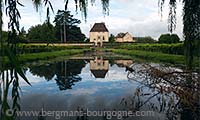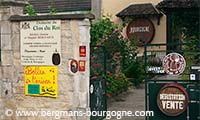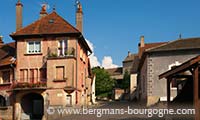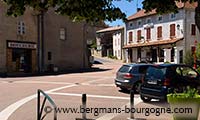
p behind the Côte d'Or is the Hautes-Côtes. The character of the countryside is quite different to the Côte d'Or. The vines are no longer dominating the picture. Instead there are pasture and woodlands; as well as other crops than grapes. This part of Burgundy is a big producer of the black currants used for the Créme de Cassis. It is slightly cooler up here, something that becomes obvious when you drive from the Côte d'Or. On a summer's day there is usually a difference of a couple of degrees.
The Hautes-Côtes is divided into two parts – the Hautes-Côtes de Beaune and the Hautes-Côtes de Nuits. These correspond roughly to the Côte de Beaune and the Côte de Nuits down below. Up in the Hautes-Côtes life is quiet. It is far from the big roads and the bustling life of the larger villages and towns.
Back in 1961 the Hautes-Côtes received its own appellations – Bourgogne Hautes-Côtes de Nuits and Hautes-Côtes de Beaune; both regional appellations. This was important for this part of Burgundy. With the new appellation it got an identity of its own; it was no longer lumped together with all the others in the large regional Bourgogne appellation. When the phylloxera wiped out the vines the people in the Hautes-Côtes turned to polyculture, mixing winegrowing with other crops and milk production.
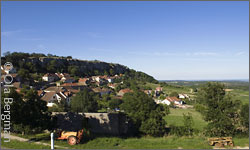 – The appellation that the Hautes-Côtes got in 1961 was very important because it meant that the wines produced in the Hautes-Côtes were in a way higher in classification, compared to the generic Bourgogne appellation, explains Claire Naudin at Domaine Henri Naudin-Ferrand in Magny les Villers. Economically this was essential because in the Hautes-Côtes we usually have poor soils, and we produce less than some areas classified as Bourgogne. This means that we cannot compete with the Bourgogne appellation. Our production costs are usually higher. Having our own appellation, it helps us selling at a price (a bit higher) that allows us to live on these vineyards.
– The appellation that the Hautes-Côtes got in 1961 was very important because it meant that the wines produced in the Hautes-Côtes were in a way higher in classification, compared to the generic Bourgogne appellation, explains Claire Naudin at Domaine Henri Naudin-Ferrand in Magny les Villers. Economically this was essential because in the Hautes-Côtes we usually have poor soils, and we produce less than some areas classified as Bourgogne. This means that we cannot compete with the Bourgogne appellation. Our production costs are usually higher. Having our own appellation, it helps us selling at a price (a bit higher) that allows us to live on these vineyards.
Before the phylloxera there were 4500 ha of vines in the Hautes-Côtes. In the 1950's only 400 ha were left. Then came the Hautes-Côtes appellations and between 1975 and 1990 the area under vines doubled. Today the area under vines is well over 1400 ha. 450 winegrowers are making Hautes-Côtes de Beaune or Hautes-Côtes de Nuits wines. Out of these 450 winegowers 180 are also living somewhere in the Hautes-Côtes.
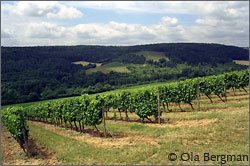 – Having an appellation of our own also means that officially the wines from the Hautes-Côtes are better compared to simple Bourgogne, continues Claire Naudin. We belong to what is called "Bourgogne plus". This is also important. If you do your best to do better, first your wine is more expensive to produce and it is important to sell it at a higher price. Secondly it is good that people can know that your wine is supposed to be better. Then, are "Hautes-Côtes" better than simple "Bourgogne"? Customers have to judge. I do believe so, most of the time. Hautes-Côtes can be great wines, and Bourgogne also! And both can be disappointing...
– Having an appellation of our own also means that officially the wines from the Hautes-Côtes are better compared to simple Bourgogne, continues Claire Naudin. We belong to what is called "Bourgogne plus". This is also important. If you do your best to do better, first your wine is more expensive to produce and it is important to sell it at a higher price. Secondly it is good that people can know that your wine is supposed to be better. Then, are "Hautes-Côtes" better than simple "Bourgogne"? Customers have to judge. I do believe so, most of the time. Hautes-Côtes can be great wines, and Bourgogne also! And both can be disappointing...
In 1968 the co-operative cellar of the Cave des Hautes-Côtes was founded; this is now the only remaining co-operative in the Côte d'Or. In 1989 it swallowed both the co-operative in Pommard and the Union des propriétaires de vins fins de Gevrey-Chambertin. Originally it was based up in the Hautes-Côtes, in the hamlet of Orches, but was later moved to Beaune where it got a much more strategic location out on the Route de Pommard. Today the Caves des Hautes-Côtes represents 600 ha and has an annual output of three million bottles, split between 74 appellations. Back in the day when Bernard Rocault – father of François Rocault at Domaine Blandine & François Rocault – and six of his friends started the venture the surface area was a mere three hectares. The Rocault family has a very long history in Orches. They have been winegrowers for 15 generations here; the name first appeared in 1391 and in 1470 Jacques Rocault, the first in a long line of winegrowers, was born.
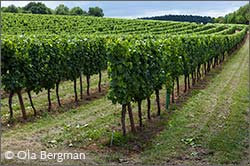 Orches lies in the commune of Baubigny, just a kilometre or so southwest of Saint-Romain. As in Saint-Romain you have the steep cliffs here, only in Orches the village seems to be glued up against them. How the 90 villagers manage to get up there in the wintertime when there is snow is a mystery to me. But in any case it must close to impossible to get anything but a splendid view if you check into one of the chambres d'hôtes here. The view from up here is great and the village offers plenty of charm. Considering the size there are quite a few chambres d'hôtes in Orches. There are also places where you can rent bikes, quads and horses.
Orches lies in the commune of Baubigny, just a kilometre or so southwest of Saint-Romain. As in Saint-Romain you have the steep cliffs here, only in Orches the village seems to be glued up against them. How the 90 villagers manage to get up there in the wintertime when there is snow is a mystery to me. But in any case it must close to impossible to get anything but a splendid view if you check into one of the chambres d'hôtes here. The view from up here is great and the village offers plenty of charm. Considering the size there are quite a few chambres d'hôtes in Orches. There are also places where you can rent bikes, quads and horses.
If you continue south you soon reach Evelle and then Baubigny.
There are 19 communes that are entitled to the appellation Bourgogne Hautes-Côtes de Nuits and 22 communes that are entitled to Bourgogne Hautes-Côtes de Beaune. Another seven communes in the department of Saône-et-Loire have the right to use Bourgogne Hautes-Côtes de Beaune. Usually the wine is sold without any notion of lieu-dit or such. But there are exceptions. Domaine Lucien Jacob in Échevronne makes a lovely white Bourgogne Hautes-Côtes de Beaune from "Les Larrets" and Domaine Guyon makes an equally lovely red Bourgogne Hautes-Côtes de Nuits "Cuvée des Dames de Vergy".
© 2013 Ola Bergman










